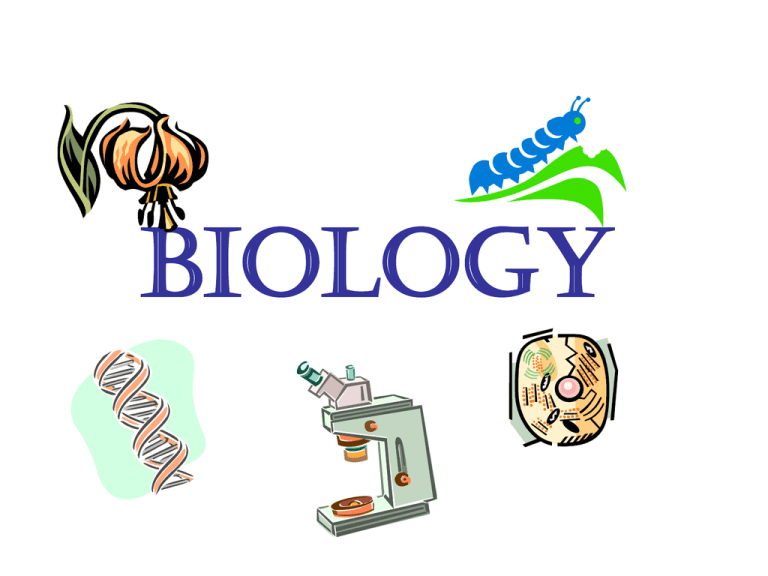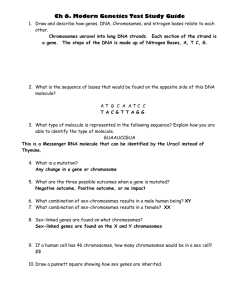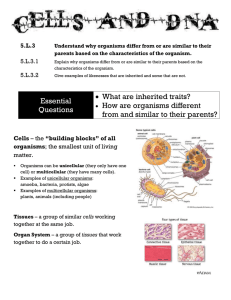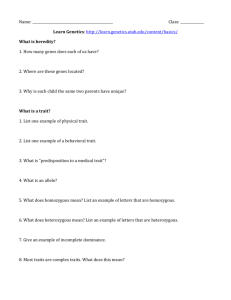Cells - KCPE-KCSE
advertisement

BIOLOGY Introduction to Biology Lab Experimentation & Safety Characteristics of Life Scientific Method SI Units Tools Biologists Use Lab Experimentation & Safety Safety Contract Teachers Attend Safety Training Intranet Access to Safety Manual Pg 75 August In-service Activity: Lab from Hell Characteristics of Life Living things are made up of units called cells. Unicellular & multicellular Living things reproduce. Asexual & bisexual Living things are based on a universal genetic code called DNA. Living things grow & develop. Living obtained/get and use materials and energy (metabolism). Living things things maintain an internal balance (homeostasis). This balance involves water, chemicals, and reactions with the organisms’ body. Living things change over time (evolution). Notes, Key, & Lab: Characteristics of Life 5 Steps Scientific Method 2. State the problem Form a hypothesis 3. Set up a controlled experiment 1. independent variable (I change) dependent variable Constants or controlled Record & analyze results Draw a conclusion 4. 5. Lab Reports Lab Activity: Brand & Absorption Notes & Key : Scientific Method; Activity and Key: Can You Spot the Scientific Method SI Units •Metric System is a decimal system based on multiples of 10. 1000 100 10 1 .1 .01 .001 Kilo- Hecto- Deca- Unit deci- centi- milli- drinking chocolate milk. (m,L,g) King Henry Died Monday •M = Meter is the unit for length •L = Liter is the unit for volume •Cm3 = centimeters cubed is the unit for volume •G = Gram is the unit for mass •Degree or Celsius is the unit for temperature. • Examples of Conversion Worksheet & Key Tools Scientist Use Triple Beam Balance Digital Electronic Scale Ruler/Metric Stick Goggles & Apron Glassware Graduated cylinders Flasks Beakers Slides & cover slips Forceps (tweezers) Microscopes LINK: Tool of the Life Scientist Microscopes Anton van Leeuwenhoek was the first man to use a microscope to see living organisms. Types Microscopes Light Microscope & Compound Microscope Electron Microscope SEC TEM Monocular Microscope Binocular Dissecting Microscope Microscope and their Function LAB: Microscope & Pond Water Links: Microscope Vocabulary Game Classification • Carolus Linnaeus • Taxonomic Hierarchy – KPCOFGS – Binomial Nomenclature • 6 Kingdoms • Using Dichotomous Keys http://www.park.edu/bhoffman/courses/bi225/labs/Dichotomous%20Keys%202.htm • Viruses- non-living, therefore not a taxonomic group http://www.biology-online.org/1/9_pathogens.html Notes & Key: Viruses 6 Kingdoms • Archaebacteria previously Monera Links: http://www.cellsalive.com/howbig.htm http://www.cellsalive.com/toc.htm#microbiol • Eubacteria • Protista • Fungi • Plantae • Animalia Comparing Kingdoms • • • • Basic Structure: Prokaryotes vs. Eukaryotes # Cells: Unicellular vs. Multicellular Energy: Autotroph vs. Heterotroph Cell Wall Composition: cellulose, chitin, peptidoglycan Domain Kingdom Cell type # cells cell structures mode of nutrition example Bacteria Archaea Eub act eria A rchaeb act eria Pro t ist a Eukarya F ung i Plant ae A nimalia Ecology Populations Ecosystems Succession Humans and the Environment Notes & Key: Ecology Teacher Notes Population • Population size – Refers to the number of individuals in a population – Factors that influence this size • Abiotic – nonliving, such as temperature, moisture, air, salinity, and pH • Biotic – all the living organisms that inhabit the environment • Population density – Refers to the number of individuals found within a given area – If too wide spread, they rarely encounter each other – difficult to reproduce • Dispersion – Refers to the way in which the individuals of the population are arranged • Even – individuals are located at equal intervals • Clumped – bunched together in clusters • Random – location of each individual is determined by chance • Population Growth – population grows when more individuals are born than die • Carrying capacity – when a population has reached the maximum size that the environment can support – Size is determined by limiting factors – Food, water, shelter • Populations living areas – Habitat = the area in which an organism lives – Niche = the role the organism has in an ecosystem • Population relationships – Symbiosis – close association between two different types of organisms – a scientific ‘living together’ • Mutualism – both organisms benefit (lichen) • Commensalism – one organism benefits and the other is neither harmed nor helped (epiphytes) • Parasitism – one organism benefits and the other is harmed (flea) Ecosystems • Energy Flow – Producers - make their own food (green plants, algae, some bacteria) – Consumers - obtain their food from others • Herbivores – primary consumers that eat plants • Carnivores – secondary consumers that eat flesh • Omnivores – secondary or tertiary consumers that eat plants and flesh • Decomposers – eat dead and decaying organisms • Food Chain – Trophic levels • Clover • Rabbit • Snake • Hawk • Food Web – Food chains that interconnect – and overlap • Pyramid of biomass – Total mass of organisms at each trophic level • Pyramid of numbers – Number of organisms at each trophic level • Pyramid of energy – Amount of energy at each trophic level – Each trophic level receives ~ 10% from the next higher level • Cycles – Water cycle • Nonliving – Condensation, precipitation, evaporation • Living – Absorption, transpiration • Carbon cycle – Atmospheric carbon – Photosynthesis – Cellular respiration • Nitrogen cycle – Atmospheric nitrogen – Nitrogen-fixing bacteria – Nitrates – Nitrites – Plants – Animals – Decomposers • Oxygen cycle – Oxygen in air and water – Cellular respiration – Water – Photosynthesis Succession • Populations in an area are replaced by other populations – Organisms make the environment less conducive for their existence and more conducive for the next level • Primary succession – where life did not exist before – Pioneer species – Continuing species change – Climax community – Ex. lichen, grasses, small bushes, small trees, mature softwoods (pines, balsams, firs), mature hardwoods (oaks, hickories) • Secondary succession – where a prior community was destroyed (by fire, flood, volcanic eruption, abandoned farming, mining, logging, etc.) – Pioneer species – Continuing species change – Climax community Humans and the Environment • Conservation – Wise management of the Earth’s natural resources – Renewable resources – Nonrenewable resources • Renewable resources – Wildlife • Many threatened or endangered • Extinction occurs when a species disappears from Earth • Habitat destruction is major cause – Forests • Becoming smaller due to increased demand for wood and wood products • Deforestation occurs where large areas of forest are cut and cleared. Ex. tropical rainforests – – – – Cut and burned to clear land for farming Topsoil is thin, good for one, or maybe two, years Then more must be cleared When land is cleared, rain ceases as trees caused the rain through transpiration – Land becomes a desert Reforestation is a solution • Soil – good soil is needed to grow plants for food and for fibers to make cloth – Erosion can be prevented • Windbreaks • Contour plowing • Terrace plowing • Strip cropping • Crop rotation • Nonrewable resources – Water • Most important • Cannot live without it • Watersheds • Desalination Fossil Fuels Coal, natural gas, oil Alternative energy forms solar energy nuclear energy wind power geothermal energy water energy • Pollution – Air pollution • Most comes from burning fossil fuels • Smog – smoke and fog • Acid rain – oxides from burning fossil fuel combine with moisture in air • Temperature inversion – Layer of warm air becomes trapped between layers of cool air – Air pollutants become trapped in cool air – Do not rise form the earth, stay near ground – Water pollution • Agricultural runoff • Industrial waste products – One major example is hot water – Causes thermal pollution – Hot water holds less oxygen than cold water – Land pollution – when people do not properly dispose of trash • Destroys natural beauty of our land • Killing animals that eat it or become trapped in it • Recycling is an answer • Some materials taken from: • Biology by Dean Medley • The Living World by George B. Johnson Biochemistry • Atomic Structure • Elements- CHNOPS • Water Chemistry • pH scale • 4 Major Groups of Macromolecules • Nature of Enzymes Atomic Structure Nucleus: protons and neutrons Orbitals: electrons, 8 electrons fills orbital Protons + Neutrons = Atomic mass Isotopes- differing # of neutrons Proton # = Atomic Number = Electron # Atomic Mass # - Proton number = Neutron # # Electrons determines reactivity and bonding Carbon easily bonds with several other atoms because it has only 4 electrons in outer orbital Covalent bonds- electrons are shared Ionic bonds- electrons are lost or gained creating ions which are attracted to each other Links: http://www.chemguide.co.uk/atoms/properties/gcse.html Bohr Model http://www.classzone.com/books/earth_science/terc/content/investigations/es0501/es0501page01.cfm Elements Most common in living things- CHNOPS Water Chemistry/Properties Polarity and effect on bonding Properties-Excellent solvent, cohesive, adhesive, high specific heat, high heat of vaporization, less dense when frozen pH scale Strong acid 0 7 acids neutral 14 basic (alkaline) Most living things prefer neutral pH Links: http://www.uni.edu/~iowawet/H2OProperties.html http://www.oceansonline.com/water_props.htm Strong base 4 Major Groups of Organic Molecules Carbohydrates Lipids Proteins Nucleic Acids components C, H, O C, H, O C, H, O, N C, H, O, N, P monomers monosaccharide (ex-glucose) fatty acids and glycerol amino acids nucleotides lipid bilayer (membranes) fat (stored energy, insulates) hemoglobin (transport) enzymes (catalysts) antibodies (defense)... DNA (direct protein synthesis) RNA (role in proteinsynthesis) Polymers examples & function starch, glycogen (energy) cellulose, chitin (structural) Enzymes Enzymes are proteins that catalyze reactions. The reaction may build a larger molecule or breakdown a large molecule into parts. Enzymes and substrates fit together like “lock and key”. Reaction rate is also affected by temperature and pH because they may alter the shape of the enzyme. Links: http://www.lewport.wnyric.org/jwanamaker/animations/Enzyme%20activity.html Lab: Catalase Cells • Cell Theory – Three Statements of Cell Theory • All living things are made of one or more cells • The cell is the basic unit of life • Cells come from preexisting cells. – Scientist who helped Develop Cell Theory • Robert Hooke – 1st Observed Cells (Cork Cells) • Anton van Leeuwenhoek – 1st to see living cells (in pond water). • Matthias Schleiden – All plants are made of one or more cells • Theodor Schwann – All animals are composed of many cells • Rudolph Virchow – All cells come from preexisting cells. Cells continued • Types of Cells – Prokaryotic • Bacteria – Eukaryotic • Animal • Plant • Structure, Functions and Analogies of Cell Parts – Chart and Key – Note cards – Cell City Cells continued Animal Cells continued Plant Cell membrane Cells continued Prokaryotic Cell Wall Ribosomes Flagella Chromatin (DNA) Cell Membrane Cells Continue Organelles • In Animal & Plants – – – – – – – – – – – Nucleus Nucleolus Chromatin Nuclear Membrane Cytoplasm Mitochondria Golgi Apparatus (Complex) Cell Membrane Ribosomes Lysosome ER = Endoplasmic Reticulum (Rough & Smooth) – Vacuole Activity and Key: Cell Chart • Only in Animal – Centrioles • Only in Plant – Cell Wall – Chloroplast – LARGE Central Vacuole Cells Continued Diffusion & Osmosis • Diffusion is the process by which molecules spread from areas of high concentration to areas of low concentration. When the molecules are even throughout a space - it is called EQUILIBRIUM Osmosis • the diffusion of water (across a membrane) • Selectively Permeable - membranes that allow some things through, the cell membrane is selectively permeable, water and oxygen move freely across the cell's membrane, by diffusion Video: “Osmosis Jones” by Warner Brothers Family Entertainment Photosynthesis & Respiration Photosynthesis Cellular Respiration (aka- Aerobic Respiration, Respiration) Equation CO2+H2O+light->C6H12O6+O2+H2O Flow of energy sun->producers (plants and algae)->consumers Equation C6H12O6+O2+H2O->CO2+H2O+ ENERGY (ATPs) Glucose is broken down, energy is released and tranferred into ATP molecules Storage of energy Glucose molecule has stored energy Chloroplasts ATP Readily available energy for cell use Adenosine Tri Phosphate Mitochondria Site of photosynthesis in eukaryotic cells Autotrophic Organisms Site of cellular respiration in eukaryotic cells Autotrophic and Heterotrophic Organisms General Overview info with helpful illustrations: Links: http://www.phschool.com/science/biology_place/biocoach/photosynth/overview.html http://www.phschool.com/science/biology_place/biocoach/cellresp/intro.html The Evolution of Living Things Teacher Notes What is a theory? Based on educated guesses Supported by evidence Believed by many to be true NOT a proven fact. Could be disproved by new evidence. a characteristic that helps an organism survive and reproduce in its environment. Three examples of adaptations are: structures for finding food for protection for moving from place to place Group of organisms that can mate with one another to produce fertile offspring. HOW MANY SPECIES EXIST? Species of Hawaiian honeycreepers Estimates of the Numbers of Species in the World Groups of Organisms Species described Maximum estimates Most conservative estimates Viruses 5,000 500,000 500,000 Bacteria 4,000 3,000,000 400,000 Fungi 70,000 1,500,000 1,000,000 Algae 40,000 10,000,000 200,000 Plants 250,000 500,000 300,000 Vertebrates 45,000 50,000 50,000 Nematodes 15,000 1,000,000 500,000 Mollusks 70,000 180,000 200,000 Crustaceans 40,000 150,000 200,000 Arachnids 75,000 1,000,000 750,000 Insects 950,000 100,000,000 8,000,000 Source: World Conservation Monitoring Centre, Global Biodiversity - Status of the Earth's Living Resources, 1992. •Scientists estimate the Earth is 4.6 billion years old •Fossil evidence shows that many species have died out and many new species have formed. Process by which populations accumulate inherited changes over time. FOSSILS- remains of organisms that have been preserved or petrified in sediment (sand, mud, or small rocks). Newest/ Most Complex Oldest/Simplest “EVIDENCE” of EVOLUTION 1. 2. 3. 4. 5. The Fossil Record Vestigial Structures Comparing Skeletal Structures Comparing DNA Embryonic Structure Salamander Baleen Whale Boa Constrictor Vestigial Structures: remnants of once used structures. Humerus Radius Pterodactyl Ulna Carpals Metacarpals Dolphin Dog Phalanges Human Bird Bat Flying Seal Swimming Sheep Running Shrew Grasping Similar Skeletal Structures Extinct dodo's DNA linked to pigeons British team tracks ancestry of humans' first evolutionary victim David Perlman, Chronicle Science Editor Friday, March 1, 2002 The legendary dodo, a flightless bird extinct for more than 300 years, has yielded its DNA for the first time, and scientists say it is related to pigeons in Southeast Asia and even, though more distantly, to San Francisco's own flocks of the often-scorned scavengers. From a scrap of skin and a bit of bone, British biologists at Oxford University, together with an American graduate student from Georgia, have created a fascinating genealogy for the weird creature…. The genetic findings, along with the volcanic history of the islands in the Indian Ocean where the bird originated, show that the dodos probably descended from an unknown ancestral bird some 42 million years ago that flew from Africa to what are now the Mascarene Islands east of Madagascar. Two separate species of descendants -- the dodo (Raphus cucullatus) and a close, flightless relative called the solitaire (Pezophaps solitaria) evolved some 26 million years ago. Millions of years later, they took roost on two separate Indian Ocean islands: the dodo on Mauritius and the solitaire on nearby Rodrigues. DELICATE ANALYSIS The evolutionary history comes from a delicate and difficult kind of DNA analysis …. EMBRYO DEVELOPMENT Closely related organisms look alike during early development; they look different as they mature. FOSSIL RECORD: A historical sequence of life indicated by fossils found in the layers of the Earth. Gaps exist because specific conditions are necessary to form fossils. (Buried in fine sediment without oxygen.) DNA, RNA & Protein Synthesis • DNA->RNA->Protein (flow of genetic information, gene expression, central dogma) • History: Watson & Crick model • Structure of DNA • Meiosis/Gamete Production review • DNA Replication Steps • Importance/Function of Proteins • Protein Synthesis- mRNA, tRNA, rRNA Chart and Key: Comparison of DNA and RNA Teacher Notes: DNA, RNA, & Protein Synthesis DNA • Structure – Polymer of nucleotides – 4 nitrogen bases – Complementary bases/pair rules • Replication – – – – Unzip double strand Each strand serves as template Free nucleotides bond to templates Form replicated chromosomes- relate to cell cycle •Link: http://www.lewport.wnyric.org/jwanamaker/animations/DNA%20Replication%20%20long%20.html •Lab- build and manipulate DNA model Proteins • Strings of amino acids become proteins • Proteins are the building blocks of life: – Structural – Enzymes – Hormones – Defense – Transporters No life possible without proteins…. Protein Synthesis • Structure and Role of mRNA, tRNA, rRNA • Transcription – Unwind DNA – Form mRNA complementary strand to gene – mRNA carries instructions to ribosome • Translation – mRNA attaches to ribosome (rRNA) – tRNA brings amino acids to ribosome – Codons of mRNA determine anticodon of tRNA and consequently the amino acid order. – Peptide bond form between amino acids and form polypeptide – Polypeptide becomes functional protein Link: http://www.lewport.wnyric.org/jwanamaker/animations/Protein%20Synthesis.html Lab- Model process Activity- Draw, Color and label process Comparison of DNA and RNA table • The Cell spends the majority of the time in Interphase of the Cycle Cycle • The rest of the time it spends in Mitosis where the nucleus divides • Once the nucleus divides, cytokinesis begins separating the cell in two G1 (Gets bigger) A T M P S = Synthesis G2 (Makes new organelles) • Makes Body Cells (ex:Toe) • Cell division of the cell & nucleus occurs • Cell division starts with one cell & ends with two cells that are exactly like the original cell • 4 Phases • Prophase – chromosomes appear clearly • Metaphase– chromosomes line in middle • Anaphase – chromatids pull apart and cytokinesis begins • Telephase – chromosomes unwind and cytokinesis ends Chart & Key: Comparison on Mitosis & Meiosis Links: Mitosis and Mitosis NOTES: MEIOSIS Two Types of Cells • Body cells (diploid cells): full set chromosomes Examples: all cells but sex cells • Sex cells (haploid cells): half number chromosomes Examples: egg (ova) = female sperm = male HUMAN EXAMPLE: body cells = 46 chromosomes or 23 homologous pairs sex cells = 23 chromosomes (one from each pair) see fig. 9, pg. 114 When sperm fertilizes egg, each parent contributes 23 chromosomes (One from each homologous pair) 23 (female) + 23 (male) = 46 chromosomes total (23 homologous pairs) How many TOTAL chromosomes does each fly have? 8 How many HOMOLOGOUS CHROMOSOMES does each fly have? 4 MEIOSIS •Cell division that makes sex cells. •Chromosomes copied once •Nucleus divides twice •1 cell makes 4 Link: Meiosis Worksheet SEX CHROMOSOMES • Carry genes that determine whether offspring is male or female • In humans: – XX = female • (egg only has X chromosome) – XY = male •(sperm contains either X or Y chromosome) FATHER DETERMINES GENDER! X passed on = girl, Y = boy The passing of traits from parent to offspring…. Teacher Notes HUMAN GENETIC INFORMATION • Stored in 23 pairs of chromosomes • Chromosome 1 = largest & is 3x bigger than chromosome 22. • 23rd pair of chromosomes = sex chromosomes (X or Y) • Chromosomes made of DNA. • Genes = special units of chromosomal DNA. • CHROMOSOME 1: OVER 3000 genes • CHROMOSOME 14: Approx. 1400 genes • CHROMOSOME 19 Over 1700 genes • CHROMOSOME 21 Over 400 genes TERMS TO KNOW • GENE: segments of DNA that carry heredity instructions; located on chromosomes & passed on from parent to offspring. • ALLELES: alternative (different) forms of a gene that governs the same characteristic. (One set of alleles from mom & one from dad.) • GENOTYPE: inherited combination of alleles (The genes you have – one set from mom, one from dad!) • PHENOTYPE: organisms inherited appearance (What you physically look like.) IT’S A GAME OF CHANCE… • PROBABILITY: mathematical chance that an event will occur. • DOMINANT TRAIT: trait observed when at least one dominant allele for a characteristic is inherited. • RECESSIVE TRAIT: trait that is observed when two recessive alleles for a characteristic are inherited. HOMOZYGOUS v. HETEROZYOUS • HETEROZYGOUS: If you have contrasting (opposite) pairs of genes for a trait. (Ex: you get a gene for attached earlobes from mom and unattached from dad.) • HOMOZYGOUS: If you have two like (same) genes for a hereditary trait. (Ex.: you receive the gene from both parent that allows you to roll your tongue.) WHAT ARE SOME TRAITS THAT ARE INHERITED? Checking out your genes…. FREE VS. ATTACHED EAR LOBES •Free earlobes are those that hang below the point of attachment to the head. •Attached ear lobes are attached directly to the side of the head. Hairline: Widow’s Peak v. Straight Chin: Dimple or No Dimple? Thumb: Straight or Curved? CHEEKS: DIMPLES OR NOT ONE CHEEK WITH A DIMPLE IS A YES! PINKY: BENT OR STRAIGHT? Straight Bent TOES: LONGEST SECOND TOE OR LONGER BIG TOE? TONGUE: ROLL IT OR NOT? FOLDED HANDS: LEFT OR RIGHT THUMB ON TOP? FRECKLES OR NOT? A little about Mendel…. • • • • Lived during the 1800’s Austrian monk Noticed patterns of inheritance Studied the ways traits are passed from parents to offspring • Discoveries not noticed for many years MENDEL STUDIED PEAS THREE REASONS: 1. Grow quickly 2. Usually self-pollinating. (Have both male & female reproductive parts.) 3. Many varieties CONTROLLED EXPERIMENTS Cross-pollination: anthers (male) of one plant are removed so that it cannot self-pollinate. The pollen from another plant is used to fertilize the plant without anthers. VOCABULARY: • TRUE-BREED: A plant that always produces offspring with traits the same as the parent(s). Also called: PUREBRED or HOMOZYGOUS • CROSS-BREED: Crossing two plants that had different forms of the same trait. (Example: white flower with pink flower.) Produces: HYBRID or HETEROZYGOUS MENDEL’S 1st EXPERIMENT •Studied 7 different characteristics •Used true-breeding plants (ex. TT with tt) •Each of the crosses was between two traits. (Example: flower color purple vs. white) •The offspring were first generation. (F1) A FEW OF THE TRAITS STUDIES BY MENDEL: Similar results for each of the crosses – one trait always appeared the other trait seemed to disappear. • DOMINANT: The name that Mendel gave to the trait that always appeared. • RECESSIVE: The name that Mendel gave to the trait that seemed to disappear. Flower Color F = purple f = white F f F Ff Ff V f Quiz Review Ff Ff Some More Vocabulary: •P generation: Parent Generation. •F1 generation: First filial generation (i.e. 1st generation after parents) •F2 generation: Generation produced from self-pollination of F1 generation. MENDEL’S 2nd EXPERIMENT •F1 generation allowed to self-pollinate. •OUTCOME?? Recessive trait appeared. •Recessive trait showed up again but not as often as the dominant trait. •Mendel calculated the ratio of dominant to recessive. (3:1) Each plant had two sets of instructions (genes) – one from each parent. These two forms of the same gene are known as “ALLELES”. Genotype both parents = heterozygous Parent 1 = Ff , Parent 2 = Ff F F f Ff FF V f Ff ff Classification • End of the year, after SOL – Material to cover • Plant Phyla • Animal Phyla – Mind Maps/Posters, Group work – Outdoor Scavenger hunts – Wildflower Collections SOL Preparation • http://www.pen.k12.va.us/VDOE/Assessment/releasedtests.html • http://etest.ncs.com/Customers/Virginia/pat_home.htm • http://www.virginiasol.com/test_grade10.htm • http://schoolisland.com Projects, Inquiry Investigation • There are literally millions of website full of experiments. • Easy experiments will teach scientific method and reinforce or introduce students to new biological concepts. • Excellent websites for science activities: Links: http://ei.cornell.edu http://www.epa.gov/epahome/educational.htm SOURCES • Holt, Rinehart, Winston. (2002) Life Science. • Images: Google.com • Movie: www.unitedstreaming.com








